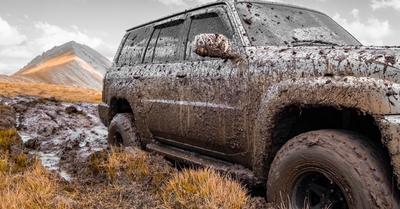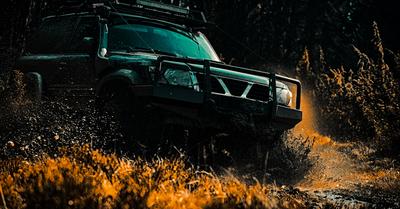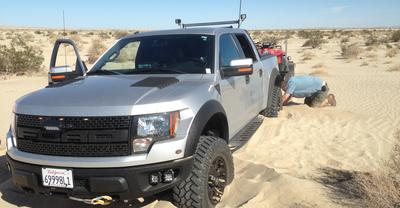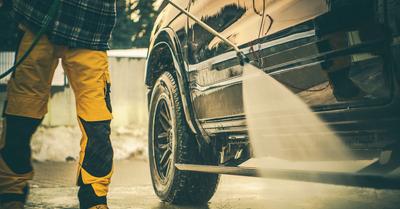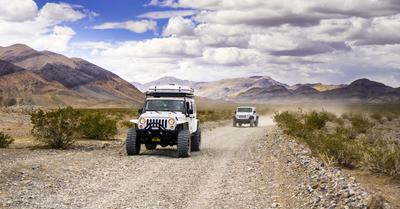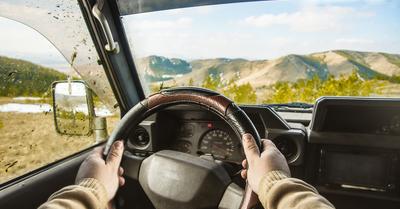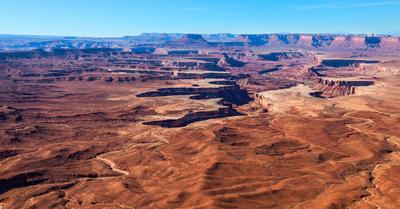The off-roading community is massive, and it may be difficult to find a place to start. With a few steps, you can get started off-roading in no time.
To start off-roading, try to find a friend to take you along on a trail before buying a vehicle. After you find an off-road truck, SUV, or Jeep of your own, you can practice on easy trails and advance to more challenging terrain.
In this article, we'll cover everything you need to know about off-roading as a beginner. We'll cover some frequently asked questions about off-road driving and show you how to find fellow enthusiasts and choose the best vehicle.
We have extensive off-road experience, and we also spoke with other off-roaders to help put together this article.
This article may contain affiliate links where we earn a commission from qualifying purchases.
What Is Off-Roading?
Off-roading is a sport, a pastime, a hobby, a necessity, and just about everything in between. Off-roading in its simplest form is just driving on surfaces that aren't paved. But it means a lot more than that to most people, as off-roading is a popular activity that has a massive market and community built around it.
Your typical off-roader likes driving on challenging terrain and testing both their skill and the capabilities of their vehicle. There are many different kinds of off-roading, including mud bogging, rock climbing, overland, and good old-fashioned woods exploration.
Off-roading involves an element of risk to both you and your vehicle. The roads can be perilous, and you'll need a certain level of skill to traverse them safely and without getting stuck. Luckily, there are endless locations to practice on easier trails.
Off-roading is also about community. It's a mixture of outdoorsy types, avid car enthusiasts, and competitors who all have something in common—and it's very easy to make friends. The off-road community has dozens of sub-groups, such as the Toyota guys, the Baja bug people, monster truck builders, classic off-roaders—the list goes on.
Is Off-Roading Expensive?
Yes and no. Off-roading can be as cheap as filling your vehicle with gas and hitting the trails—but it usually takes more investment than this if you're serious. Many people off-road their daily driver, provided it's something that's capable of driving on uneven and unpredictable terrain.
Others buy an entirely different vehicle solely for the purpose of off-roading, and some buy multiple. The cost of off-roading is entirely dependent on how much you want to spend and what kind of vehicle you want to do it with.
If your current car is unsuitable for off-road driving, you can get into a functional 4x4 of some kind for just a few grand. Now granted, it probably won't be that interesting, but it's a start—and you can always save up for a better off-roader down the line.
How Much Experience Do You Need for Off-Roading?
Again, it depends. Anyone who's a good driver can get started on basic trails right away. Give it a go on a local unpaved road and see what you think. Cars and trucks handle differently on loose road surfaces, so it's essential to learn at least a little bit about how to safely start, stop, and get yourself out of a rut.
Ideally, it's best to shadow someone first. Find a friend who hits the trails and go along for the ride. See how the vehicle operates and how the driver handles it, and see how you like it. Getting started is not a particularly complex task, and it just takes a few tries to get the hang of it.
Off-Roading for Beginners: How to Get Started
Getting started is easy, especially if you live in a somewhat rural area. Figure out what kind of off-roading you want to do, and see if you can meet local off-readers who are already established in the hobby.
Chances are they'll be more than happy to show you the ropes, especially if it means they'll have another person with a truck to call at 2 AM when they're stuck in the mud. Here are a few steps to take to help you get started.
Go with a Friend
As we mentioned previously, the easiest way to get started is to find someone who's already off-roading. See if you know anyone who spends time driving on dirt roads. It's usually pretty easy to tell—look at what they drive, and try to remember if you usually see any dirt on it.
If it's a brand new scratch-free truck with big wheels and a lean towards the back, you're probably out of luck unless they have another vehicle. But if you see a truck with a sizable lift, dirt in the fenders, and a Summit Racing sticker on the back window, you're probably set.
If you don't know anyone who off-roads, try showing up to car meetups and truck events. You can also reach out on social media or off-roading forums to find someone in your location.
Find Local Trails
Finding local trails can be challenging, especially in the South, where the majority of the land is privately owned. The West enjoys millions of square miles of public land and free access, but this luxury doesn't extend to other parts of the country.
Some areas have online guidebooks detailing local trails, service roads, and other areas where trucks are welcome. These resources are helpful, and they can also let you and your buddies in on some unknown trails.
But if you still can't find anything, try asking around and seeing what the locals are already doing. Avoid trespassing, as landowners usually don't appreciate lifted trucks tearing up their ranch roads uninvited.
Choose a Vehicle
Choosing the right off-road vehicle is the most challenging (and most fun) part of learning how to off-road. There are numerous kinds of vehicles available, including (but not limited to) trucks, Jeeps, and SUVs. We'll get into this more later.
Practice on Easy Trails
Once you have something to drive, practice on some easy trails and bring a truck or two along with you. Hit the trail during the summer, during the winter, when it's dry, and when it's muddy. This will help you master control of your vehicle and help you learn instinctually how to deal with any kind of terrain you encounter.
Make Modifications to Your Vehicle
If you identify weaknesses in your vehicle (or just want to upgrade some parts), don't be afraid to make modifications. Modding is one of the most fun parts of off-roading, and it can be reasonably affordable if you make the right purchases.
Just about everything is available to modify your off-road vehicle. Wheels, tires, suspension, winches, bumpers, lights, fender flares—you name it, they've got it for sale.
Try Advanced Trails
Once you learn the ropes, you can begin riding advanced off-roading trails. This is where the fun begins. You can drive any kind of trail you want, provided it's within the abilities of your vehicle.
There are thousands of incredible off-road trails with varying levels of difficulty around the country, and you can always make the sacred off-road pilgrimage to Moab, Utah, for an epic photoshoot with your truck.
How to Choose an Off-Road Vehicle
Choosing an off-road vehicle can be difficult without any guidance. It's always good to ask other people's opinions, but don't let them convince you to get something just because they have one. Here's an overview of the most common types of off-road vehicles.
Trucks
Trucks are the most common vehicle used off-road. Trucks are utility vehicles that are well-suited for off-roading thanks to their high ground clearance and tougher mechanical parts. Additionally, many trucks come with four-wheel-drive from the factory, which is a universal benefit.
SUVs
SUVs are more spacious than trucks, and they're often built on shared platforms. That means with a full-size SUV like the Chevrolet Suburban, you'll get the same off-road capabilities as the Chevrolet Truck.
Trucks are often less expensive than SUVs. But SUVs are a lot more practical as daily drivers. An SUV is a great option if you're looking for a regular day-to-day car with plenty of room and off-road capabilities.
Jeeps
A Jeep Wrangler is technically an SUV, but the Jeep has such a long and separate history that it gets its own category. Additionally, Jeeps have fundamental design differences that make them superb off-roaders.
Jeeps have features like solid axles, manual transfer cases, and easy-to-fold windshields that other SUVs either never had or ditched decades ago. Although they lack creature comforts and a smooth ride, Jeep Wranglers (and their descendants) are the best out-of-the-box off-roaders on the market.
New Vs Used Vs Old Off-Road Vehicles
New off-road vehicles fetch a hefty price tag. In fact, there's not a single new off-road truck or SUV you can buy for less than $25,000 unless you get some incredible rebates.
New off-road vehicles usually come with tons of advanced electronics to help you navigate difficult terrain. People might make fun of you for using them, but they can be extremely helpful in a pinch.
Used off-road vehicles, such as those made anywhere between 1999 and 2020, are the most common and affordable. These are all fundamentally modern and reliable vehicles that do quite well off-road.
Old off-road vehicles, such as Ford Trucks made before 1998 and anything else made before 1993, are likely the most durable and easy to modify. There's a wealth of knowledge surrounding these vehicles, and a bit of work can make one just as reliable as a newer off-roader.
Classic off-road vehicles, such as the original Ford Bronco, Ford Highboy, Chevy K10, or International Scout, are extremely capable. These vehicles are sometimes more capable than newer trucks due to their heavier components and simplicity.
You'll have to learn how to maintain it and keep your tools on hand, but an old off-road vehicle can be extremely rewarding and help you generate some great skills. Remember, you're doing all the work—these vehicles don't have any computers to help out.


